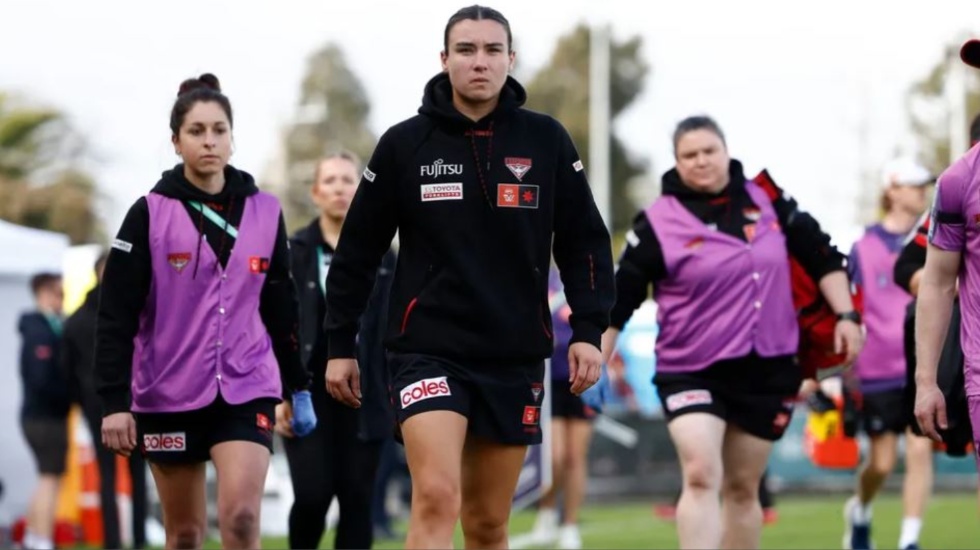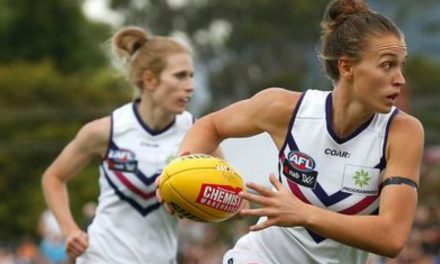Essendon co-captain Bonnie Toogood after injuring her knee against Fremantle in Round 1. Photo: AFL MEDIA
A wave of serious injuries to key players in the AFLW is threatening to become an epidemic. Only two rounds into the 2024 season, four club captains are done for the year.
Ange Stannett of Fremantle, Janelle Cuthbertson of Port Adelaide, Essendon co-skipper Bonnie Toogood, and most sensationally, Sydney’s Chloe Molloy, are the big names on the sidelines, with AFLW officials already praying more bad luck isn’t on the horizon.
Molloy and the Swans have been roundly criticised for their subterfuge with the public and players before their round two match about her having ruptured her anterior cruciate ligament.
But the smoke of the Swans’ “Knee-gate” and who knew what and when, must not obscure for the league the raging fire causing it. Literally and figuratively, the AFLW is knee-deep in a health crisis it must exhaust every available means to extinguish. The issue is soft tissue.
This is not the league’s first early-season rash of damaged ACLs, PCLs and MCLs. In 2019, only one of the league’s then-10 clubs had a player who didn’t suffer an ACL injury.
In the opening round of 2022, three of the league’s brightest stars succumbed to serious knee injuries – Brisbane’s Kate Lutkins, the previous season’s grand final best on ground, Collingwood’s Bri Davey, the league’s co-best-and-fairest, and Bulldog Isabella Huntington – all lost for the season.
All three players subsequently returned and are plying their trade, with Huntington since shifting to GWS, but what about the continued risk to their long-term knee health?
Athletes shouldn’t ever be deterred from living out their professional sporting dreams because of injury risks, but maximising injury prevention must be a higher priority if AFLW is to successfully make its best players and on-field leaders the household names they deserve to become.
Medical professionals worldwide acknowledge that, anatomically, women athletes are more susceptible than their male counterparts to serious knee injuries.
“The structure of the knee joint in women plays a big role in putting them at a higher risk,” says doctor Andrew Cosgarea in an article on the website of Johns Hopkins Medical Centre, a US-based, world-renowned health facility.
“Women’s joints – including the knee – generally have more looseness and range of motion than men’s. Women also have less muscle mass around the knee, contributing to more instability, which can lead to a ligament tear if the ligament gets overstretched.”
PLEASE HELP US CONTINUE TO THRIVE BY BECOMING AN OFFICIAL FOOTYOLOGY PATRON. JUST CLICK THIS LINK.
Earlier this year, IDA, a woman-owned US sports shoe manufacturer, rolled out and made available to the public a line of athletic footwear specifically designed for women. IDA claims its shoes offer greater heel and toe support, a tongue that causes less irritation, and studs that boost traction, all in an effort to “mitigate ACL injury risk”.
Though many of IDA’s products are labelled as soccer boots, its website features an image of a Brisbane player holding up a pair of she wore in last year’s grand final, and Australian retailers are advertising them online as suitable footy boots.
While AFLW has yet to officially recommend or endorse IDA boots, the VFLW’s Darebin Falcons advertise on their website a promotional partnership with IDA, touting the manufacturer’s Classica Women’s Football Boot as ideal because of its “unique female foot mould” and its being built for “firm ground”.
Whether Stannett, Cuthbertson, Molloy and Toogood were wearing IDA boots at the time of their injuries has yet to be revealed. And of course, no shoe in human history has ever been or likely ever will be invented that will prevent injury. No women’s footy boots can work magic like the mythical pair of glass slippers worked for Cinderella.
But AFLW would be wise to take a leaf from Qantas – at least in its unconventional approach to an aspect of the long-term sustainability of its product.
The airline, in an unprecedented attempt to shrink the globe in commercial aviation, launched “Project Sunrise”. It challenged the world’s two leading civil aviation giants, Boeing and Airbus, to design the first commercial passenger aircraft that could safely, regularly, and reliably ferry customers directly between Sydney and New York, 16,000 kilometres apart.
While the jury is out on the veracity of the claim of serious knee injury mitigation IDA says it offers, perhaps an AFLW version of “Project Sunrise” could recruiting the world’s leading orthopedists, sports scientists, and athletic shoe manufacturers to develop health-sustaining footwear as revolutionary to professional women footballers as Qantas’s Airbus A350-1000 Ultra Long Range may become to international travellers when the aircraft is scheduled for take-off in 2026.
Keeping its best players on the park is in the AFLW’s best interests. And the sky should not be the limit in how high the league is willing to invest in its most crucial human assets.











